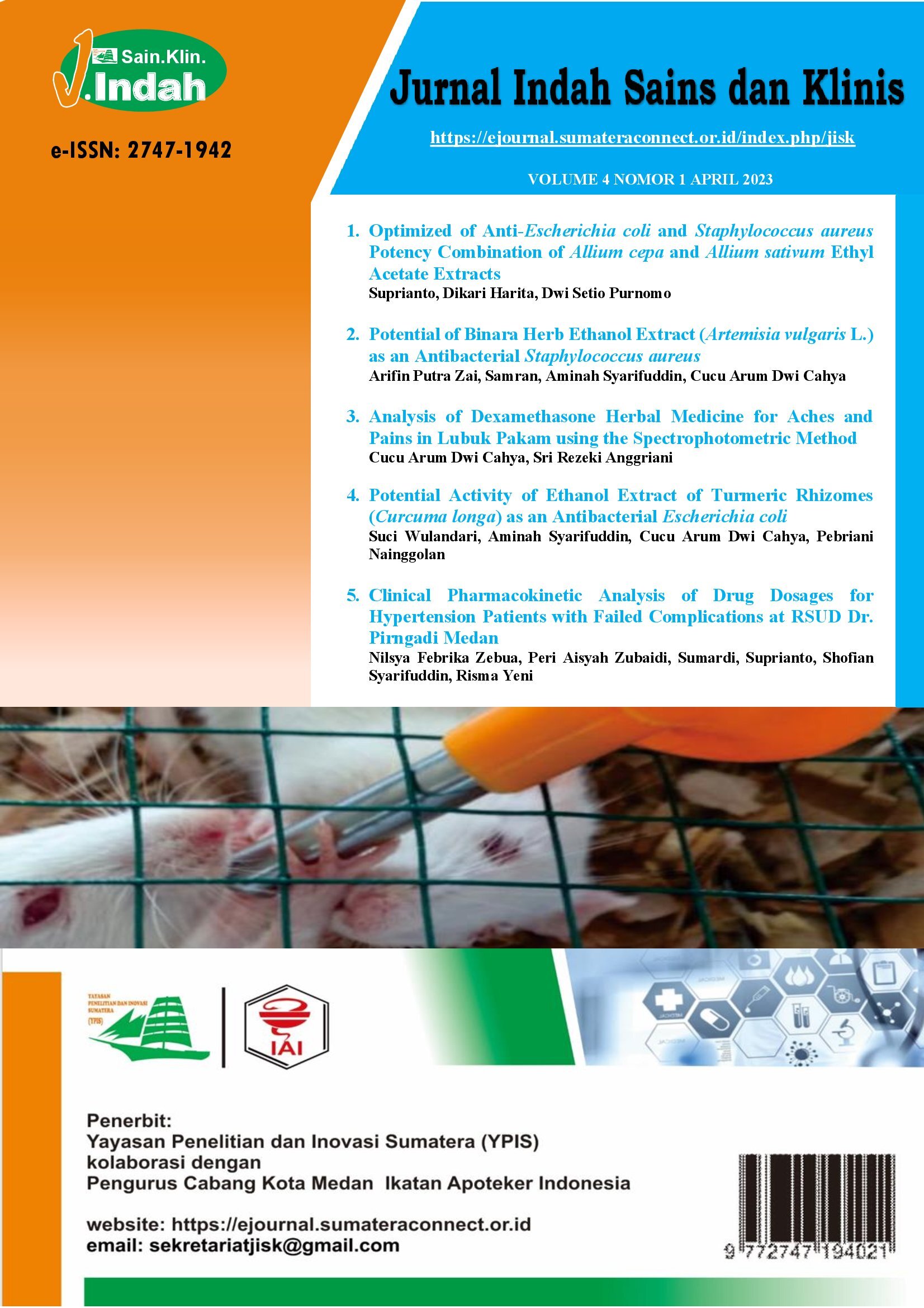Potensi Aktivitas Ekstrak Etanol Rimpang Kunyit (Curcuma longa) sebagai Antibakteri Escherichia coli
DOI:
https://doi.org/10.52622/jisk.v4i1.04Kata Kunci:
Turmeric, potency, antibacterial, Escherichia coliAbstrak
Background: Turmeric (Curcuma longa) is well known as one of the many medicinal plants in the form of rhizomes, both on a home and industrial scale. The chemical components contained in the rhizomes include fat, ascorbate, protein, starch, tannin, curcumin, flavonoids and essential oils. Turmeric is commonly used by people to reduce the frequency of diarrhoea. Apart from having chelating properties, it is also anti-inflammatory and even antibacterial. Objective: The study was directed to investigate the potential of ethanol extract of turmeric rhizomes (EERK) on Escherichia coli. Method: Dry rhizome powder was macerated using 96% ethanol, then rotary evaporated to obtain dry turmeric rhizome extract (EKRK), and divided into concentrations of 30, 40, and 50%, positive or negative control. Results: The study shows that there is an influence of EKRK concentration on the antibacterial potential of Escherichia coli. One-way ANOVA described that there was a significant difference (p < 0.010) in the use of various EKRK concentrations as inhibitors of bacterial growth and development. Antibacterial activity at 30, 40, and 50 % was 14.3, 17.5, and 19.7 mm, respectively. Conclusion: EERK has strong potential as an antibacterial for Escherichia coli.
Unduhan
Referensi
A. Pangemanan and F. Budiarso, “Uji Daya Hambat Ekstrak Rimpang Kunyit (Curcuma longa) terhadap Pertumbuhan Bakteri Staphylococcus aureus dan Pseudomonas sp.,” eBiomedik, vol. 4, no. 1, pp. 81–85, 2016.
R. M. Rumanti, S. Suprianto, J. Tarigan, and A. M. S. Ramadani, “Potensi Antibakteri Kombinan Zingiber officinale Roscoe. Var. Rubrum dengan Cinnamomum burmannii terhadap Staphylococcus aureus,” J. Indah Sains dan Klin., vol. 2, no. 1, pp. 6–10, 2021, doi: 10.52622/jisk.v2i1.8.
L. Fikayuniar, N. S. Gunarti, and M. Apriliani, “Uji Aktivitas Antibakteri Ekstrak Etanol Rimpang Kunyit (Curcuma longa L.) terhadap Staphylococcus Aureus dan Pseudomonas Aeruginosa,” Pharma Xplore J. Sains dan Ilmu Farm., vol. 4, no. 1, pp. 278–287, 2019.
A. Retnaningsih, “Uji Daya Hambat Rimpang Kunyit (Curcuma domestica Val) dan Rimpang Temulawak (Curcuma xanthorriza Roxb) terhadap Bakteri Salmonella thypi,” Holistik J. Kesehat., vol. 9, no. 3, pp. 158–160, 2015.
L. Meliala, W. Sari, and P. Tarigan, “Uji Efek Antidiare Ekstrak Rimpang Kunyit (Curcuma domestica val.) Pada Mencit Jantan,” J. Penelit. Farm. Herb., vol. 2, no. 2, pp. 15–21, 2020.
Y. Yuliati, “Uji Efektivitas Ekstrak Kunyit Sebagai Anti Bakteri Dalam Pertumbuhan Bacillus sp Shigella dysentriae Secara In Vitro,” J. Profesi Med. J. Kedokt. dan Kesehat., vol. 10, no. 1, pp. 26–32, 2016.
O. J. Sumampouw, Mikrobiologi Kesehatan. Yogyakarta: Deepublish, 2019.
L. A. Lestari, E. Harmayani, T. Utami, P. M. Sari, and S. Nurviani, Dasar-Dasar Mikrobiologi Makanan Di Didang Gizi dan Kesehatan. Yogyakarta: UGM Press, 2018.
R. Maksum, Mikrobiologi Panduan Mahasiswa Farmasi dan Kedokteran. Jakarta: Penerbit Buku Kedokteran EGC, 2016.
M. N. Putri, “Uji Efek Antibakteri Infusa Daun Karamunting (Rhodomyrtus tomentosa (Aiton) Hassk) terhadap Pertumbuhan Bakteri Staphylococcus aureus,” Institut kesehatan helvetia, 2018.
S. Desrini, “Resistensi Antibiotik, Akankah Dapat Dikendalikan?,” J. Kedokt. dan Kesehat. Indones., vol. 6, no. 4, pp. i–iii, 2015.
J. B. Harborne, Metode Fitokimia, Penuntun Cara Modern Menganalisis Tumbuhan. Bandung: Penerbit ITB, 1987.
E. Septiana and P. Simanjuntak, “Aktivitas Antimikroba dan Antioksidan Ekstrak Beberapa Bagian Tanaman Kunyit (Curcuma longa),” Fitofarmaka J. Ilm. Farm., vol. 5, no. 1, pp. 1–10, 2015.
S. Y. Pasaribu, “Pembuatan Media Pertumbuhan Bakteri dengan Menggunakan Umbi Ubi Jalar Oranye (Ipomoea batatas (L.) Lam) terhadap Bakteri Streptococcus mutans, Streptococcus sanguinis dan Staphylococcus aureus,” Universitas Sumatera Utara, 2019.
A. N. Faidiban, J. Posangi, P. M. Wowor, and R. A. Bara, “Uji Efek Antibakteri Chromodoris annae terhadap Bakteri Staphylococcus aureus dan Escherichia coli,” Med. Scope J., vol. 1, no. 2, pp. 67–70, 2020.
N. Rahmawati, E. Sudjarwo, and E. Widodo, “Uji Aktivitas Antibakteri Ekstrak Herbal terhadap Bakteri Escherichia coli,” J. Ilmu-Ilmu Peternak., vol. 24, no. 3, pp. 24–31, 2014.
T. P. T. Cushnie and A. J. Lamb, “Antimicrobial Activity of Flavonoids,” Int. J. Antimicrob. Agents, vol. 26, no. 5, pp. 343–356, 2005.
B. Kaczmarek, “Tannic Acid with Antiviral and Antibacterial Activity as a Promising Component of Biomaterials—A Minireview,” Materials (Basel)., vol. 13, no. 14, p. 3224, 2020.
Y. Yan, X. Li, C. Zhang, L. Lv, B. Gao, and M. Li, “Research Progress on Antibacterial Activities and Mechanisms of Natural Alkaloids: A Review,” Antibiotics, vol. 10, no. 3, p. 318, 2021.
Unduhan
Diterbitkan
Terbitan
Bagian
Lisensi
Hak Cipta (c) 2024 Jurnal Indah Sains dan Klinis

Artikel ini berlisensiCreative Commons Attribution-NonCommercial-ShareAlike 4.0 International License.










